Does Morro Bay support healthy eelgrass beds?
Yes, the amount of eelgrass in the bay has increased rapidly over the last few years, with acreage surpassing pre-decline levels.
Eelgrass Status in the Estuary

How to Read Estuary Health Symbols
The Estuary Health Symbols represent how the status of each question is changing over time. A round symbol indicates that the trend is stable. An arrow indicates an improving trend (up arrow) or a worsening trend (down arrow). The color of the base of the arrow indicates the status of historical data and the color of the triangular part of the arrow indicates the status of the newer data. The color of the symbol indicates the status as follows: Good/Very Good (green), Fair (yellow), Poor (orange), Very Poor (red), and Unknown (grey).

This symbol indicates that the water quality was Very Poor and has improved to Poor.

This symbol indicates that the trend is stable but we lack adequate data to assign a status.

Very Good/Good

Fair

Poor

Very Poor

Unknown
Indicator Symbol: Very Good/Good
Hover symbol for indicator information
Eelgrass is a flowering plant that serves many important functions in an estuary. Its roots help hold bay sediments in place, which reduces erosion and keeps the waters clear. Eelgrass sequesters carbon, which keeps it out of the atmosphere and helps mitigate the effects of climate change. As a photosynthesizing plant, eelgrass also puts oxygen into the water to support other aquatic life. The plant’s floating blades form a sort of underwater forest that provides shelter and a place to find food for a wide variety of wildlife.
The Estuary Program has led efforts to map eelgrass for the past twenty years. The 2007 map indicated 344 acres of eelgrass. Over the next decade, eelgrass experienced a precipitous decline to only 13 acres. Since 2017, mapping has indicated an eelgrass recovery, with 500 acres mapped in 2021. Although the reasons for the decline and rapid recovery are not fully understood, a combination of factors such as water quality and elevation change likely played a role. Restoration efforts have also bolstered the recent recovery.
Eelgrass Acreage: 2007, 2017, and 2021
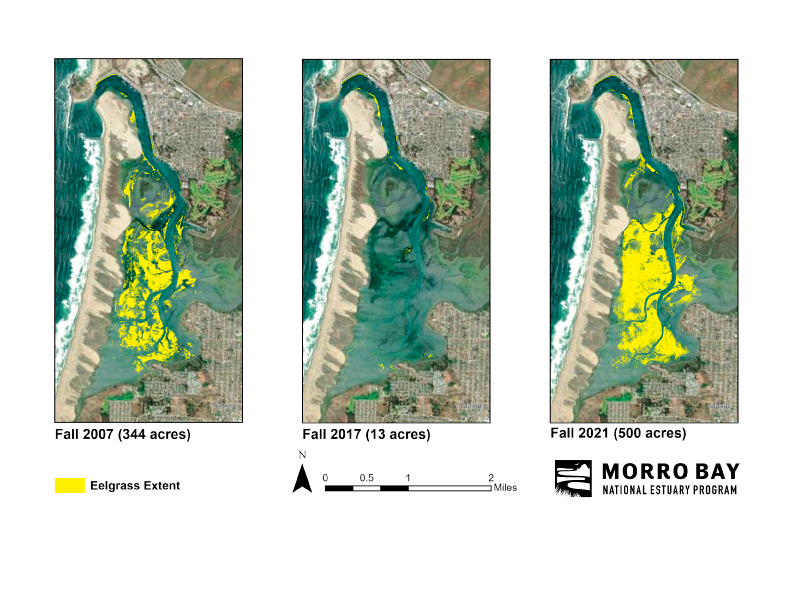
Eelgrass: Shaping the Ecosystem
Seagrasses, such as eelgrass, are ecosystem engineers that beneficially shape the biological, chemical, and physical environment around them and sustain themselves through these processes. One example of this is the seagrass-sediment-light relationship. Eelgrass reduces tidal velocity and wave energy, resulting in sediment deposition and retention near the eelgrass beds. The eelgrass stabilizes the sediment, which helps keep the waters clear and allows more light to reach the bay floor. This in turn supports eelgrass photosynthesis and growth. The opposite happens when eelgrass abundance declines. Currents and wave energy near the beds increase, leading to sediment suspension and erosion. The free-floating sediment clouds the waters and reduces eelgrass’s ability to photosynthesize, ultimately affecting its survival and growth. When eelgrass is lost, the increased erosion and reduced water clarity can lead to an unvegetated state which inhibits future eelgrass growth.
In recent years, scientists have witnessed this cycle in Morro Bay. Large areas of the estuary where eelgrass disappeared during the decline eroded and became deeper. Areas where eelgrass beds remained stable are shallower by comparison.
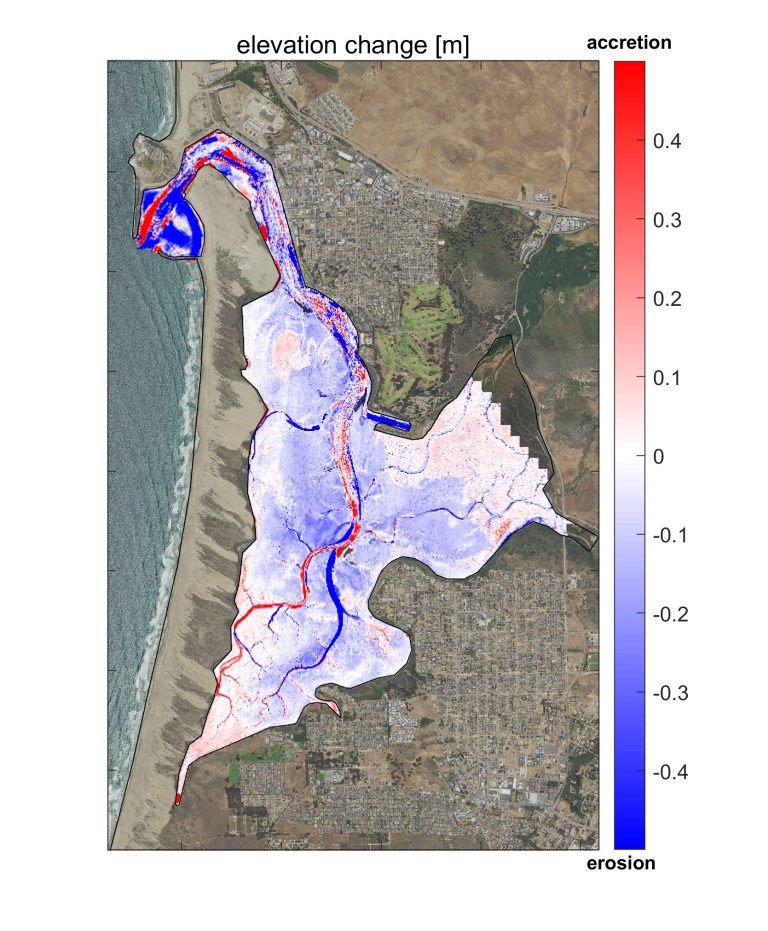
Eelgrass Mapping: Behind the Scenes
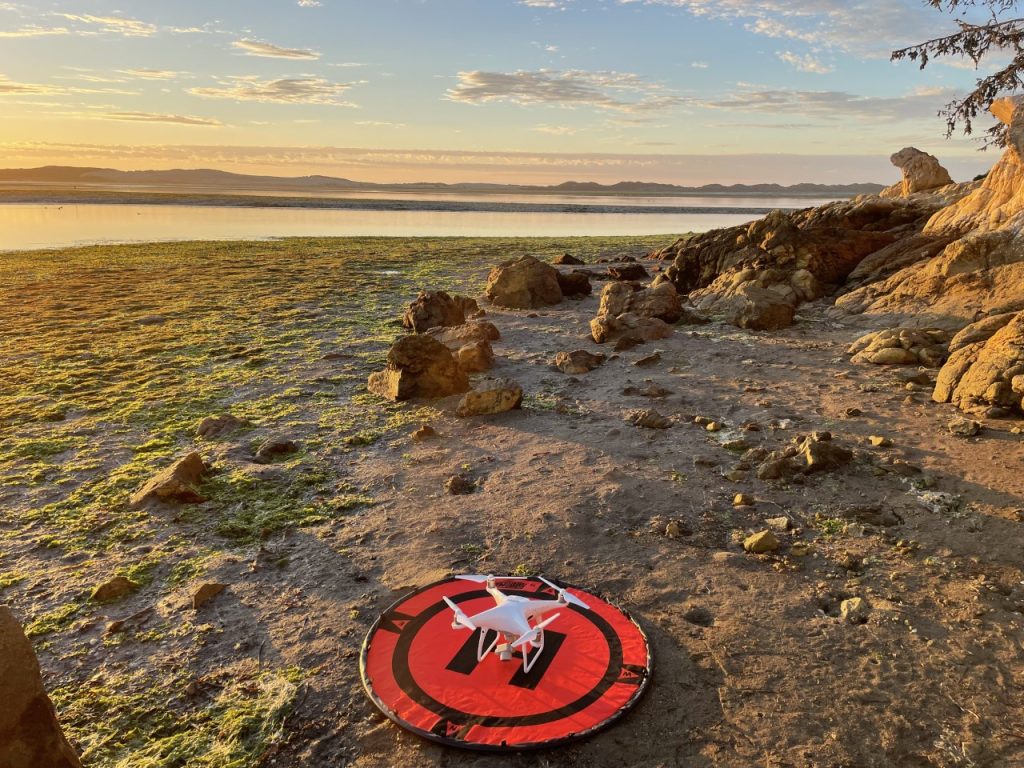
The Estuary Program started mapping eelgrass in 2002, building upon previous efforts that date back to the 1960’s. The mapping methods have changed over time along with advances in technology. Currently, the map is created in partnership with Cal Poly using high-resolution imagery captured by drone. The drone is programmed to fly a pre-determined path, allowing it to fly in precise lines across the bay and ensuring its camera records every square meter. After the drone has completed its flight, the photos are stitched together into one large, continuous map. Technicians use software to pick out patches of eelgrass, which are then added up to calculate the total acreage of eelgrass and produce the final bay-wide eelgrass map.
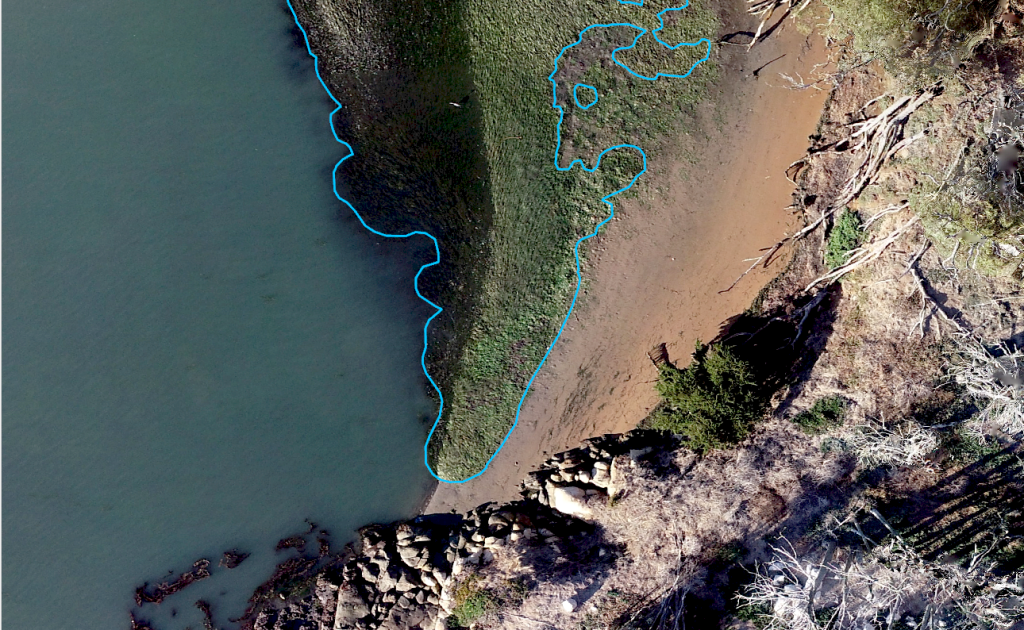
Eelgrass Restoration
Faced with a large-scale eelgrass decline, the Estuary Program led restoration efforts from 2017 to 2021 with partners including Cal Poly, Tenera Environmental, Inc., and many volunteers. Over the last five years, nearly 15,000 plants were harvested from healthy eelgrass beds and transplanted at 39 sites in both intertidal and subtidal areas. With 500 acres of eelgrass mapped in 2021, the Estuary Program has ended restoration efforts and will continue to monitor the health of existing eelgrass beds and track large-scale changes in acreage over time.
Eelgrass Monitoring: Behind the Scenes
Cal Poly Eelgrass Research Efforts
Microclimate Experiment
Monitoring Our Bay's Waters
The Central and Northern California Ocean Observing System (CeNCOOS) is a federal program that established a network of buoys along our coast to collect water quality data. The Estuary Program provided funding to help support two solar-powered water quality stations in Morro Bay – one at the T-pier near the bay mouth and one in the back bay near the oyster farms. Cal Poly operates and maintains these stations. The sensors at both stations show near-real time water quality measurements, including data for conductivity, salinity, temperature, dissolved oxygen, chlorophyll, turbidity, and pH. Both stations contain cellular modems to transfer data back to Cal Poly campus servers.
This data is readily accessible via the CeNCOOS web portal and is used by the Estuary Program as well as researchers, educators, and the community to better track water quality in Morro Bay. The data supports efforts to better understand the impacts of climate change and shifts in the bay ecosystem.
Data from the front bay sensor array is available in near-real time in a dashboard view that summarizes recent data and via a data portal that provides more detail.
A summary view of the water quality from the back bay sensor array is available in a dashboard view, and detailed meteorological data is also available.
Cuesta College Studies Eelgrass Wasting Disease
Upcoming Project: Macroalgae Monitoring
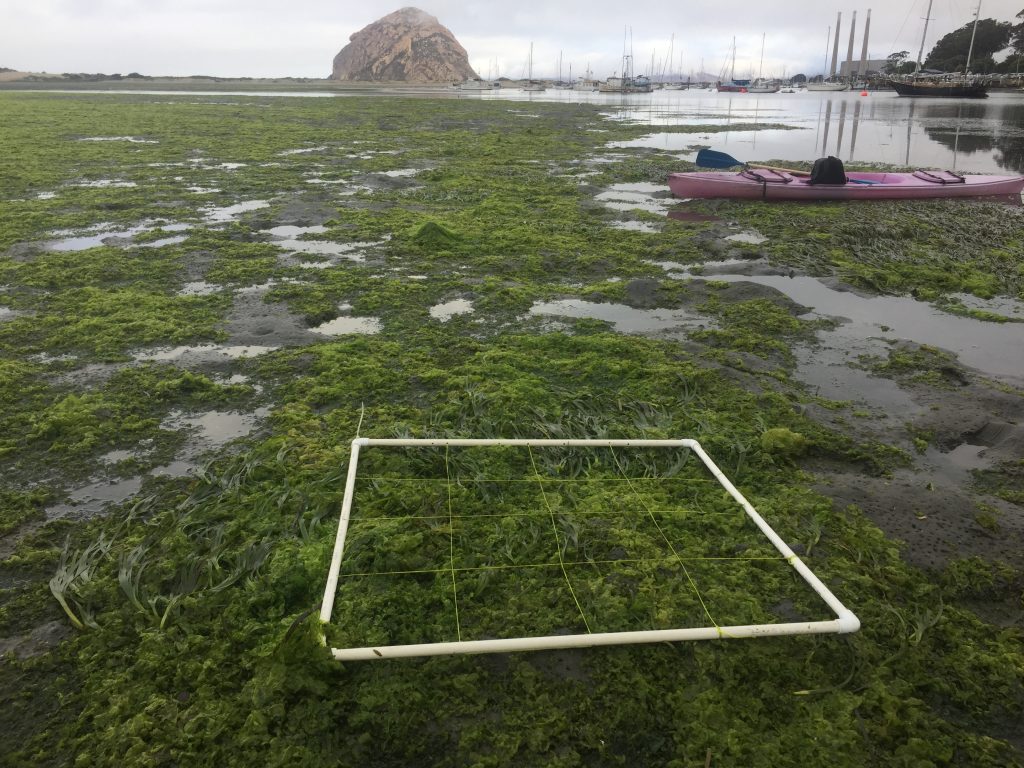
Macroalgae can play a beneficial role in an estuary, providing food, habitat, and nutrient cycling in the bay. However, when excess macroalgae is present, it can have a variety of negative impacts on eelgrass and water quality. We have observed a recent increase in macroalgae, and eelgrass monitoring efforts indicate areas where macroalgae outcompeted eelgrass, as pictured above. A project is currently in development to assess algae coverage and biomass throughout the estuary in order to track these changes in abundance and their impact on eelgrass health.
Building Partnerships & Community Support for Eelgrass Recovery
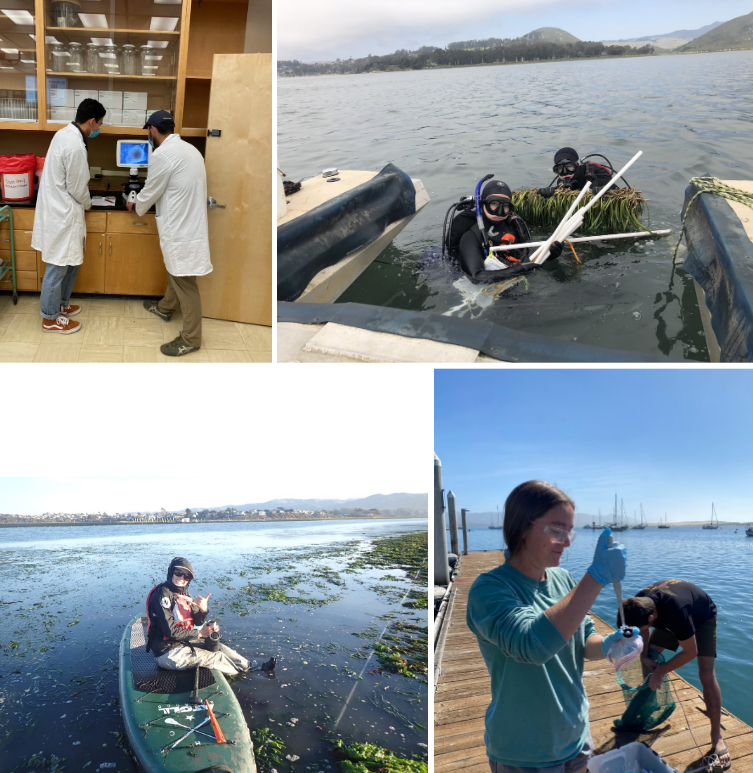
We are grateful for the many partners and community volunteers who joined us in eelgrass restoration and monitoring efforts. The work would not have been possible without this support! From 2017 to 2022, our volunteers spent nearly 500 hours getting wet and muddy while helping to harvest and plant eelgrass. Some people came out for a few hours, while others returned to help year after year. Cal Poly and California Sea Grant staff played a large role in developing initial experiments to determine the optimal restoration and monitoring methods. Tenera Environmental, Inc., a local consulting firm, also supported our eelgrass efforts and more recently led the majority of planting as COVID made it challenging to use volunteers.
A huge thank you to our community volunteers, including the AmeriCorps Watershed Stewards Program.
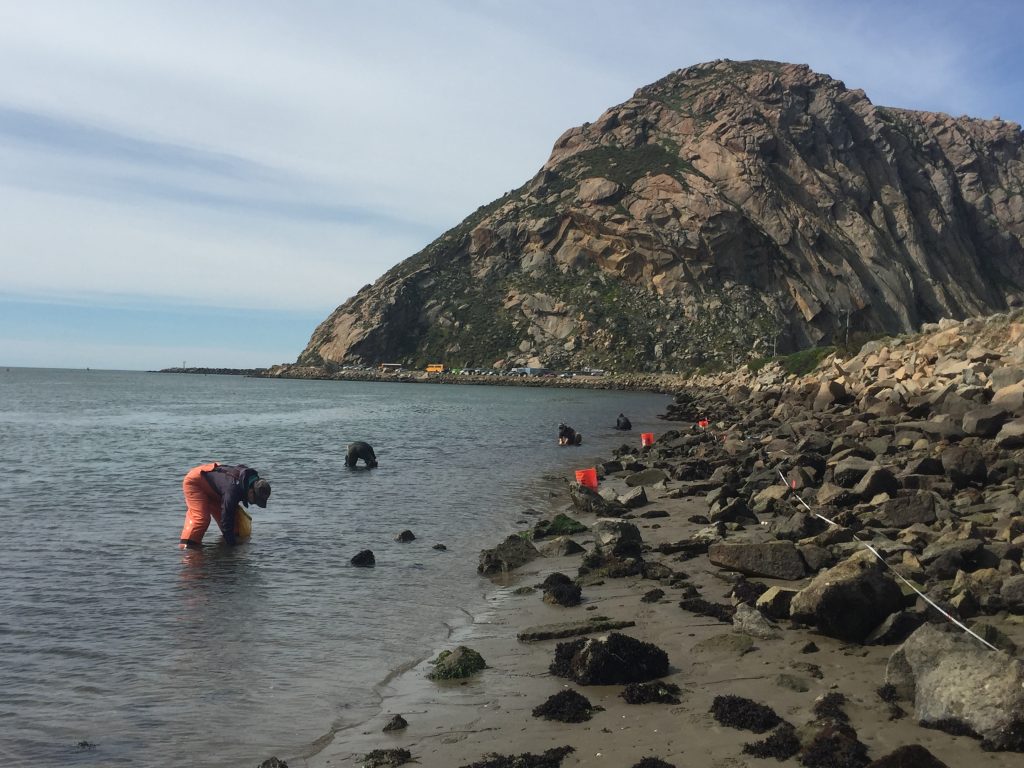
The Estuary Program has largely supported our eelgrass restoration work through grant programs such as the California Department of Fish and Wildlife Duck Stamp, Pacific Marine Estuarine Fish Habitat Partnership, Restore America’s Estuaries Coastal Watershed Grant, U.S. Fish & Wildlife Service Coastal Watershed Grant, and NOAA Sea Grant. The effort also benefited from donations from the Black Brant Group and from community members. We are grateful to the many funders who helped make this work possible.
For more information on the Estuary Program’s eelgrass work, visit our website.
Data Notes
Blog post recognizing eelgrass volunteers and donors:
https://www.mbnep.org/2022/11/11/eelgrass-restoration-gratitude-and-lessons-learned/
Dr. Ryan Walter, Large-scale Erosion Driven by Intertidal Eelgrass Loss in an Estuarine Environment: https://digitalcommons.calpoly.edu/phy_fac/591/
Estuary Program 2021 Eelgrass Report: https://library.mbnep.org/wp-content/uploads/2022/11/2021-Eelgrass-Report_FINAL.pdf
Blog post on eelgrass mapping efforts: https://www.mbnep.org/2021/12/03/field-updates-november-2021-eelgrass-monitoring-behind-the-scenes/